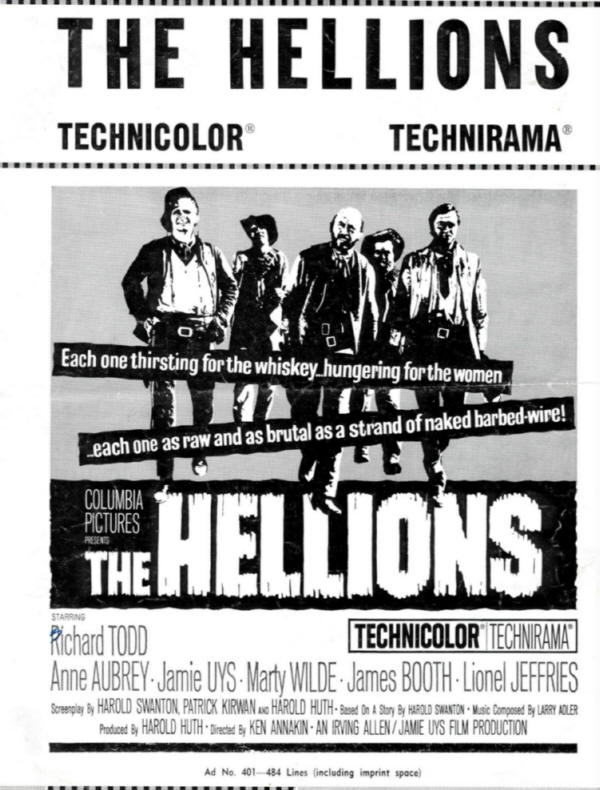
Publicity materials from The Hellions pressbook (1962)

(Review)
One of the most popular of all screen plot situations is the "shootout," that moment of drama in which hero and villain--or villains--blaze away at each other on the dusty street of a small range town. Now, along comes Columbia Pictures' "The Hellions," in Technirama and color by Technicolor at the .............Theatre, to move the shootout from the familiar frontier of the old southwest to the completely new, spectacular and exciting frontier of old South Africa.
South African lawmen, it would seem, had much the same problems with range-riding renegades as did the sheriffs and marshals of our own continent. "The Hellions" offers a considerable number of other similarities between their "west" and ours--an ingrained hatred for the barbed wire which is spoiling the range and endangering the lives of horses and humans, a citizenry reluctant to help out their local lawman whenever he has to go up against outlaw guns, and gunmen who kill, intimidate or torture for fun.
Richard Todd is cast as the police sergeant in the South African frontier town and a fine figure of a man he is, too. But when Lionel Jeffries rides into town with his four roistering sons and his deep hatred for the civilization which is growing up around him, Todd finds himself alone in his opposition. Jeffries goes after lovely Anne Aubrey, who plays the wife of a storekeeper brutalized by the renegade. The closing scenes of "The Hellions" are truly bullet-blasting.
"The Hellions" is based on a story by Harold Swanton who penned the screenplay with Patrick Kirwan and Harold Huth. Huth produced the film, and Ken Annakin directed. "The Hellions" is an Irving Allen/Jamie Uys film production for which Larry Adler composed the music.
(General Advance)
An adventure drama set in pioneer South Africa, when life in its frontier communities closely resembled that of America's lawless west. Columbia Pictures' "The Hellions" opens ...............at the ..................... Theatre in Technirama and color by Technicolor. The new film stars Richard Todd as the lone lawman in a town terrorized by an outlaw band, and Anne Aubrey, Jamie Uys, Marty Wilde, James Booth, and Lionel Jeffries.
Jeffries soon to be seen with Kim Novak, Jack Lemmon and Fred Astaire in "The Notorious Landlady," in which he plays a hapless Scotland Yard sleuth, appears in "The Hellions" as the domineering leader of the renegade family. A man who hates barbed wire and lawmen, he rides into town with his trouble-making sons determined to rid the community of both. Todd, as the lone defender of law and order, is unable to obtain help until Jeffries makes a play for the wife of a storekeeper: the man, who had taken a beating from Jeffries earlier for selling barbed wire, joins Todd in the film's breathless final "shootout."
Players in "The Hellions" are said to be uniformly excellent, and there is a wealth of color and excitement in the unusual locale. Harold Swanton wrote the story on which the film is based, and the screenplay was written by Swanton, Patrick Kirwan and Harold Huth. Huth produced "The Hellions," an Irving Allen/Jamie Uys film production and Ken Annakin directed. Larry Adler composed the music.